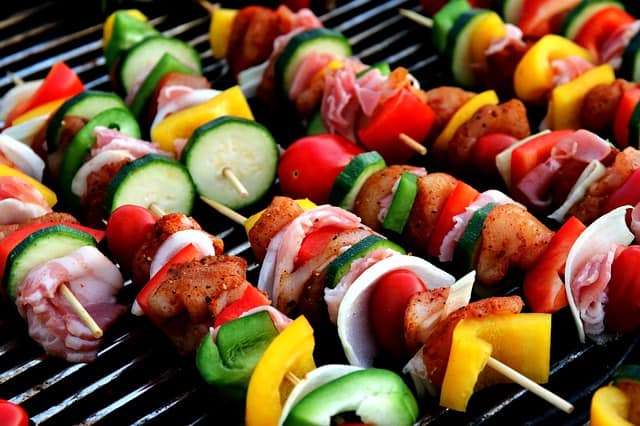Food safety and sanitization don’t have to be scary. With these seven tips for food safety at home, keeping your family and guests healthy is very simple.
 Cooking food properly is extremely important. Whether just cooking for yourself, or preparing a feast for many, there is nothing more vital in food preparation than the care taken to provide food that has been cooked to proper temperature for the prescribed amount of time.
Cooking food properly is extremely important. Whether just cooking for yourself, or preparing a feast for many, there is nothing more vital in food preparation than the care taken to provide food that has been cooked to proper temperature for the prescribed amount of time.
This, as well as taking care to having clean utensils and cutting surfaces for each individual dish will go a long way towards ensuring that food will be bacteria-free, especially if meat, fish, or poultry is featured on the menu.
Perhaps the most important item to have in the kitchen is a food thermometer. Everything from egg dishes to all forms of meat need to be cooked to a proper internal temperature before it is safe to be served, with any bacteria that may have been present eliminated by the proper heat for the proper amount of time.
The following foods need to reach the following internal temperatures before they are safe to be served:
Fresh meats
Ground meats (beef, pork, lamb, veal, deer, moose, caribou, elk): 160 degrees F.
Fresh beef, pork, lamb, veal, deer, moose, caribou, elk steaks, chops, and roasts:
- recommended minimum temperature: 145 degrees F
- Medium: 160 degrees F
- Well Done: 170 degrees F
- Leftover cooked meals: 165 degrees F, or safe to eat cold if properly cooled and chilled
Poultry and Game Birds
Ground turkey and chicken: 165 degrees F.
Whole turkey, chicken, goose, and duck: 165 degrees F.
Poultry, fully-cooked: 165 degrees F; safe to eat cold if properly cooled and stored.
Fish and shellfish
Fish and shellfish, any type: 145 degrees F.
Rabbit
All rabbit: 160 degrees F.
Ham
Fresh (raw) ham or shoulder: 160 degrees F.
Reheating precooked ham: 140 degrees F.
Eggs and Egg Dishes
Eggs: cook until white and yolk are firm.
Egg based custards and sauces; egg dishes: 160 degrees F.
Bacteria that can be present in uncooked foods can include E.coli, salmonella, and campylobacter, most prevalent in poultry.
The best way to check if meat and poultry is hot enough, outside of checking the internal temperature, is to cut into the middle of the biggest piece. If this piece is quite large, then cut into a couple of places. The piece should be steaming all the way through. When taking the food’s temperature, insert the thermometer into the middle, or the thickest part of the meat. Take the temperature for two minutes. If it maintains its minimum safe temperature in that time, it’s been cooked sufficiently.
When checking meat products for doneness, which includes meat, poultry, pork, sausages, burgers, and kebabs, cut into the middle, and check to see if: a) there is no pink inside; and b) it is steaming hot in the middle.
If cooking whole chicken or other birds, pierce through the thickest part of the leg (with a skewer or clean knife), which will be between the thigh and drumstick. Check to see the juices run out. Juices should not have any red or pink in them.
Now, contrary to some people’s belief, steak, lamb, and whole cuts of beef can be eaten rare. They must, however, be properly cooked, or ‘sealed’, on the outside of the meat. Sealing this meat kills any bacteria on the outside, and is commonly done in a frying pan over high heat.
Food that shouldn’t be eaten due to bacteria that can be all throughout the meat, not just on the outside, include poultry, pork, burgers, sausages, rolled joints, chicken nuggets, and kebabs.
Many people, when planning to cook raw poultry, will take it right out of the package and rinse it off in the kitchen sink. But this most certainly should not be done.
Chicken and poultry are carriers of a bacteria called campylobacter. Just a few campylobacter cells are needed to cause food poisoning. If rinsed in the sink, water that splashes onto hands, clothing, work surfaces, and cooking equipment can transfer this bacteria onto these surfaces very easily.
Campylobacter infection, in four of five cases, comes from poultry. Studies in the UK show that 65 percent of chickens in that country carry the bacteria. This is the UK’s most common cause of food poisoning, affecting 280,000 people a year, causing over 100 deaths annually.
7 Important Tips for Food Safety at Home
There are seven tips to follow to cook food in a proper, healthy way:
1. Keep all meats, poultry, and fish properly refrigerated until preparation time.
2. Thoroughly wash hands before beginning any food preparation, and re-wash hands after handling each different food item.
3. Only use clean knives, utensils, cutting boards or surfaces, and equipment.
4. Wash or use different cutlery when going from one food to another.
5. To avoid cross-contamination, do not use the same cutting surface for different foods. Thoroughly wash cutting boards or use different, clean ones when preparing different foods.
6. Do NOT rinse poultry before cooking (any bacteria will be eliminated during proper cooking).
7. Refrigerate any leftovers immediately after the meal. Click this freeze-drying guide to find out more.
It is worthwhile to learn more techniques from a professional chef. An experienced chef can show you how to cook in a proper healthy way and teach you practical cooking techniques. Cozymeal, an online culinary experiences marketplace, is a good start where you can find lots of cooking classes as well as cooking techniques’ classes offered by professional chefs. Have fun cooking and remember nothing beats cooking food in a healthy way.
[…] RELATED: 7 Important Tips for Food Safety at Home […]